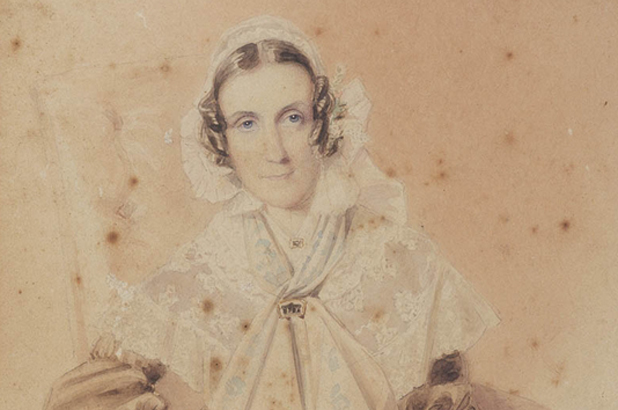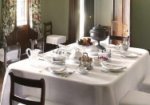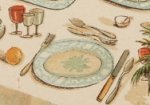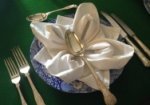A long letter by the anonymous ‘Mrs E’ to Anna Maria Macarthur gives us a marvellous insight into the social life expected of a high-class family.
“Mr Hannibal Macarthur! I desire you will not imagine that I intend to lead your wife into extravagance, but I give her a bill of fare of every sort, in case you should at some future time require a more splendid set-out than would be prudent at present.”
Married in England in 1812, Hannibal and Maria enjoyed wealth and prosperity from farming, trade and politics. They built a grand mansion, designed by the very fashionable architect John Verge, and moved in the colony’s ‘exclusive’ social circles for many years. Until, like so many over-extended pastoralists and traders, they suffered severe financial losses in the 1840s drought and economic ‘crash’ (that scenario sounds rather familiar). As Maria prepared for life in the distant colony, a ‘Mrs E’, understood to be Mrs Charles Enderby (nee Goodwyn) who Maria lived with as a child wrote her a letter of advice about entering New South Wales society. It concentrates on what Maria needed to know in order to present a fashionable, well provisioned table – with handy notes on managing the household servants.
![[The house at Vineyard, Parramatta], Conrad Martens, 1856. Caroline Simpson Collection, Historic Houses Trust Landscape showing a large house in the background.](../../app/uploads/sites/2/2012/12/x29048-The-Vineyard-med.jpg.pagespeed.ic.iMzfrIVTuv.jpg)
[The house at Vineyard, Parramatta], Conrad Martens, 1856. Caroline Simpson Collection, Historic Houses Trust
‘Rules to be observed’
Mrs E’s letter provided over 70 menu plans, there are several suggestions for ‘Family’ dinners and ‘Social’ dinners and dozens of menus for more formal dinners, anticipating between two and eighteen guests. There were ‘rules to be observed in giving Dinners’. Aside from the order of service and the correct arrangement of dishes, which The Curator will explore in a future post on setting the Regency table, you should:
not have pickled pork and bacon on the same day, nor either of those with ham and tongue, or two dishes of the same sort of meat. There are particular joints which are reckoned more genteel for company than others – Sirloin of beef, Quarter of Lamb, Haunch of Mutton, Chine of Doe [venison], or Chine of Lamb… or a very small round or edgebone of Beef.
A sociable sandwich
There are two ‘dance menus’, echoing the lifestyle so familiar from Jane Austen novels from the Regency period where dancing was a feature of social entertainment: a ‘Sociable Sandwich…in case you have a tiny Dance’ and one for ‘a Grand Dance, which you will not give – all cold but the Soups … I shall not give you a supper for a splendid ball like London ones’ (ouch!). Clearly Mrs E thought Sydney was not up to such splendour or glamour, but put the menu forward anyway.
A lavish spread
The most delightful menu, I think however, is ‘A Breakfast’, which Mrs E sketches out in her letter showing where each dish – 28 of them plus bread, butter and rolls, should be placed on the table. Eggs, chickens, ham, tongue, lobster, prawns, cake and assorted plates of fruit provide a lavish spread. An urn and ‘tea-equipage’ is set up at one end of the table, and coffee in a pot at the other. Cups of chocolate are ready poured at both ends, according to her table ‘map’. She advises:
Breakfasts of company are not usually given before 1 o’clock, and it is customary to put wine in small decanters on the table … so that the breakfast is turned into a tolerable dinner.
We might refer to this now as a boozy brunch. Our resident Regency foodie Jacky Dalton, a guide at Elizabeth Farm, has reproduced this menu (sans wine) in the Macarthur’s dining room on a few select occasions.
‘Argus Eyes’
While the pressure might be on the lady of the house to produce an elegant evening and pleasing menu, none of these meals would be possible without servants (Jacky had our museum visitors help orchestrate their ‘breakfast’ in situ). The Macarthurs are known to have treated their servants well, being one of the first families to supply tea and sugar to their staff as part of their tenure, and even paying more than the going rate for good staff. A fierce loyalty was the usual result. According to ‘Mrs E’s’ letter however, servants were not to be trusted and were sure to take advantage of a young inexperienced mistress.
“Do not leave your property ‘at the mercy of your servants” she advised: cunning cooks were likely to dupe you and be wasteful, maids were sure to wear your undergarments and the laundress might not return all your linen.
In short my dear Maria, a mistress must have Argus Eyes*, and not trust too much to her servants … observe what goes off [from the] table, or you will hear next day, that … “not one tartlet was left, and that there were only three Puffs in the dish…”
*(In Greek mythology ‘Argus’ was a particularly observant giant with a hundred eyes.)
A prudent mistress would know what had been sent back to the kitchen, and have the authority to direct how best to re-purpose it.
However petty it may seem, we must remember that the majority of the colony’s servants early in the 19th century had been transported for what we might now regard to be trifling misdemeanours, including stealing from one’s employer.
Mistress beware!
Sources
Barca, M. (ed). Advice to a Young lady in the Colony. Greenhouse Publications Pty Ltd. 1979.

![[Anna Maria Macarthur (nee King)], William Nicholas, 1843. Mitchell Library, State Library of NSW: P2 / 469 Watercolour portrait of Anna Maria Macarthur, 1843.](../../app/uploads/sites/2/2012/12/494x654xa128185h-Maria-Macarthur-med.jpg.pagespeed.ic.Y8gi_DDenw.jpg)


